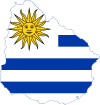List of national parks of Uruguay
Uruguay is better known for its beaches (Punta del Este, La Paloma), than for its national parks. However there are some excellent natural areas, and a system of national parks is being established. (SNAP - Sistema National de Areas Protegidas)
Eastern Wetlands and Ocean Coast
The lagoons on Uruguay's east coast are recognized as a wetland of international significance under the Ramsar Convention, due to the presence of thousands of migratory waders, ducks, swans, grebes, flamingos, herons and other waterbirds.
Rocha Lagoon - Rocha
Semi-freshwater lagoon of 72 km2 (28 sq mi). Ten kilometres by road from the beachside resort town of La Paloma (closer along the beach). The lagoon has an outlet to the sea during winter months. A bird paradise, with 220 species are recorded. Many migratory waders, Flamingos, Swans, Herons, Ducks, etc. A small fishing community live on the eastern shore (near the ocean coast), who take tourists for boat trips on the lagoon.
Castillos Lagoon - Rocha
Freshwater lagoon. Many bird species. Impressive remnants of Palm Forest (Butia) on the western shore. An unusual small forest of the curious Ombu on the eastern side (Monte de los Ombues), which resembles a tree with enormous fat trunks, but is actually a giant herb. Access from either the beachside hamlet of Valizas (Ruta 10), or the town of Castillos (Ruta 9). An eco-tourism resort close to Castillos.
Garzon Lagoon - Rocha & Maldonado
Semi-fresh lagoon. Easy access from the up-market resort town of Jose Ignacio (Ruta 10). A good place to view Penguins, Mallards, and Eagles.
Santa Teresa - Rocha
Located between Laguna Negra and the Atlantic coast, in Rocha Department, it includes several beautiful sandy beaches, a large forested area impressive, camping areas, a nature reserve for animals, a greenhouse with a wide variety of plants, and the historic fort of Santa Teresa built in Spanish colonial times (late 18th century). The park area is maintained by the army and during the summer season it has many visitors, many of whom camp in the park
Cabo Polonio - Rocha
Famous for its huge sand dunes. Actually a severely over-grazed coastal area, with very little coastal bush remaining. Miles of lovely ocean beaches, many shipwrecks. A large colony of Sea Lions and Fur Seals breed on offshore islands, with hundreds on the Cape rocks for part of the year. One of the few places on the Uruguay coast which does not have public vehicle access. Either a 7 km walk from the Ruta 10, or transport in 4WD lorries. Camping and cabin accommodation available. Two hotels and a few small restaurants. The resident population of fishing families is 88 persons.
Central Hill Country
Lunarejo Valley - Rivera
201 square kilometres of beautiful valleys and gorges, some of the most impressive landscape in Uruguay. Situated between the cities of Rivera and Artigas (on the border with Brazil). Native grassland and hill scrub, with small pockets of sub-tropical vegetation in the valleys. Many ferns (including tree ferns), orchids, bromeliads, etc. Many plant species which are not found anywhere else in Uruguay. The last known location of Tamandua (anteater) and Coendú in Uruguay. One of the few reserves with population of Coatimundi. Almost 200 bird species recorded, 31 mammals, 38 reptiles and 22 amphibians. Accommodation in the small town of Tranqueras, or in the eco-resort 'Balcones de Lunarejo'.
Crows Ravine (Quebrada de los Cuervos) - Treinta-y-Tres
Close to Treinta-y-Tres. Largest canyon in Uruguay, with sub-tropical forest in the bottom of the gorge. Many bird species which are rare in Uruguay. The name of the place derives from a crow-like species of vultures; they can be seen breeding on the cliffs. Camping and Youth Hostel at the Ravine.
Arequita National Park - Lavalleja
Arequita National Park is located in the Department of Lavalleja, 10 km north the department capital Minas. Minas is about 2 hours north of Montevideo the capital of Uruguay. The park protects Cerro Arequita a large round mesa of volcanic rock that rises above the surrounding landscape. A forest of Ombu trees and other forest species grow on the west aspect of the mesa providing habitat for a variety of native wildlife. A cave is located on the southwest side of the mesa. At one time tourists could enter the cave through a gated entrance.
Cerro de los Cuervos rises to the south of Cerro Arequita. The Rio Santa Lucia runs between the cerros and creates La Laguna de los Cuervos an ideal spot to enjoy the natural wonders of the Uruguayan countryside.
Uruguay River
Esteros de Farrapos National Park - Rio Negro
A new National Park Esteros de Farrapos and Islands of River Uruguay, which is recognised under the Ramsar Convention as a Wetland of International Significance. Esteros de Farrapos which is 174.96 km², includes 24 islands, is the last known refuge for the Puma in Uruguay, and the only protected area where Maned Wolf have been recorded. Over 200 species of birds have been recorded in the park, 30 mammals, 14 reptiles, 8 amphibians and many butterflies.
Caves
Palace Cave - Flores
It dates from the Late Cretaceous period and is composed of sandstone, which ferrified during the Paleocene. UNESCO is considering it as a possible World Heritage site, due to its interest as a geopark.[1]
References
External links
| ||||||||||
